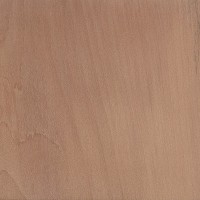 |
Common Name(s): Pear, Swiss Pear Scientific Name: Pyrus communis Distribution: Native to central and eastern Europe; Tree Size: 20-30 ft (6-9 m) tall, .5-1 ft (15-30 cm) trunk diameter Average Dried Weight: 43 lbs/ft3 (690 kg/m3) Specific Gravity (Basic, 12% MC): .52, .69 Janka Hardness: 1,660 lbf (7,380 N) Modulus of Rupture: 12,080 lbf/in2 (83.3 MPa) Elastic Modulus: 1,131,000 lbf/in2 (7.80 GPa) Crushing Strength: 6,400 lbf/in2 (44.1 MPa) Shrinkage: Radial: 3.9%, Tangential: 11.3%, Volumetric: 13.8%, T/R Ratio: 2.9 |
Color/Appearance: Heartwood is a pale pink or light reddish brown. Sapwood is slightly paler but is not usually distinct from heartwood. Pear is sometimes steamed to deepen the pink coloration. Pear is also occasionally dyed black and used as a substitute for ebony.
Grain/Texture: Grain is usually straight, with a very fine uniform texture.
Endgrain: Diffuse-porous; small pores in no specific arrangement, very numerous; exclusively solitary; heartwood mineral/gum deposits (reddish brown) occasionally present, though not easily visible with lens; narrow to medium rays not visible without lens; parenchyma diffuse-in-aggregates, though not clearly observable with hand lens.
Rot Resistance: Rated as non-durable regarding decay resistance.
Workability: Overall easy to work with both hand and machine tools. Turns, glues, and finishes well.
Odor: No characteristic odor.
Allergies/Toxicity: Besides the standard health risks associated with any type of wood dust, no further health reactions have been associated with Pear. See the articles Wood Allergies and Toxicity and Wood Dust Safety for more information.
Pricing/Availability: A popular and premium hardwood in Europe, Pear is only availability in limited quantities in the United States. Larger logs are usually turned into veneer for architectural purposes. Expect lumber and veneer prices to be high for an imported European hardwood.
Sustainability: This wood species is not listed in the CITES Appendices or on the IUCN Red List of Threatened Species.
Common Uses: Veneer, architectural millwork, marquetry, inlay, carving, musical instruments, furniture, cabinetry, and turned objects.
Comments: It’s been said that Pear is used in Europe much in the same way that Black Cherry is used in the United States: as a popular and high-quality domestic hardwood.
None available.
None available.
Scans/Pictures: A special thanks to Steve Earis for providing the turned photo of this wood species.


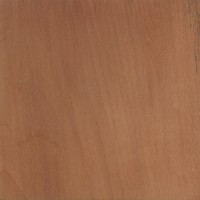
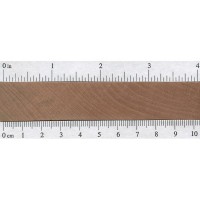
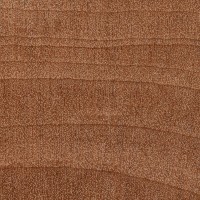
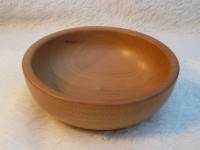




Pear is much harder then Black Cherry
the pear wood I have is super duper soft any idea why?
I could be what’s called “punky” wood, that is, partially rotted.
Oh perfect thanks so much!
I see people asking about Bradford pear, which is what I came looking to read about. Do you need a sample? I’m happy to send one.
I don’t need a sample, have one already, thanks! There seems to be no information on this wood in any of my sources. Based on my very limited observations, I found my sample of Bradford to be 5% heavier than common pear, for what it’s worth.
How do you think this extra weight might affect hardness? I tried splitting a log of Bradford and I got absolutely nowhere.
If it’s slightly heavier, then I’d expect it to be slightly harder as well. But I wouldn’t expect anything too dramatic.
Splitting isnt’a function of hardness, it’s a function of grain structure. Diffuse pourous fruit trees green off the stump, like cherry and pear, will not split clean and straight at all. To split green bradford you have to use an axe along the length of the log and expect a lot of waste.
So, essentially Bradford is so similar to Swiss it was not worth an entry into the database? BTW, I love this website. I look up things on here all the time.
Definitely going to get its own page eventually.
Are you ever going to add Bradford Pear to the database?
Yes, eventually.
Recently purchased 3 Pear wood triangular rulers marked W. Germany. Pear wood in one of its many its forms!
I’ve seen a lot of sources claiming that pear wood is used in woodwind instruments, but I have yet to find an actual instrument made of pear wood. I did see a comment under this article referencing harmonicas, which is good, but I’m wondering if anyone knows of other specific instrument that have been made from pear wood? I’m really interested in the idea of a clarinet made from it!
Pearwood very often used to make recorders. It is a step up tonewise from maple (cheapest wood used in recorders). Other fruitwoods (plum, cherry, olive) a step up from pearwood. Most sought after woods are tropical hardwoods (rosewood, cocobolo, tulipwood, kingwood), grenadilla (blackwood, used in clarinets/oboes) or European boxwood (very hard to get real thing).Antique Sound Workshop (Plymouth, MA) website has information on recorder wood choices. Attached is picture of Mollenhauer Prima alto recorder, pearwood body with beige plastic head joint, plays very well but not as nice as my palisander alto.
Further thoughts re pearwood for clarinets…a lot of baroque woodwinds originally made from boxwood (flutes, oboes, clarinets) started being made in grenadilla in the 19th century as orchestra become larger. Grenadilla has more projection and volume than any other wood. (Flutes are now mostly made of metal, another story.) The object of the exercise seemed to be increased volume rather than beauty of tone. A pearwood clarinet would not be a loud instrument. I guess you could use pearwood for a clarinet but that would definitely be a sort of one off item. It would need to be made by… Read more »
My backup fiddle (a Stainer copy…not that my #1 gets much use) has a pearwood neck. I hadn’t known it was used in instrument making but one of the luthiers in David Bromberg’s Wilmington, DE violin shop let me know when I was getting the fingerboard extended. That said, I’m not sure it’s a magical ingredient in the mix (ebony fingerboard, spruce top, maple body) but it does the job…, especially in the right hands!
some hohner Harmonicas (marine band models) have pearwood combs.
I’m making an acoustic guitar with pearwood back and sides. My first acoustic had pearwood back and neck. Also I’ve made electric one with pearwood neck and fretboard one year ago. Zero issues. Pearwood was widely used in Europe for guitar building, also beech and european walnut. But american guitars became very popular, and people wanna see use mahogany, rosewood or maple in their guitars, and don’t wanna try something different, unknown or forgotten.
Today I rough-turned a bowl from a sizable Pear tree downed by last weekend’s “atmospheric river” storm in Northern California. The wood is so wet that it rained in my workshop. While being turned, the wood gave off a faint but distinctive aroma of … pears.
Bradford pear found along side of road.
Is this the Bradford pear?
Technically, no. That would be Pyrus calleryana, which I’ve not yet added to the site yet.
If you ever the opportunity to add some metrics on Bradford Pear it would be much appreciated. Especially on your (excellent) Bow Woods article you have Pear (guessing Pyrus communis) at an estimated 10.68. We have lots of very straight bradford pear wood here that grows back even if i cut them.
I just finished turning a couple Keiffer Pear pens. Turns and finishes like dogwood and looks similar. Sands and polishes to a shine easily.
does bradford pear split easily or more interlocking grain?
It splits quite easily. We took down a storm damaged bradford pear tree at my brother’s last Saturday. The wood left for firewood split like maple or ash.
I love to work with pearwood it has no visible pores and sucks in flaxseedoil like a spounge.
In skandinavia there is only one type of pearwood that survives the climate here it´s kalled “gråpäron”or greypear all other peartrees in skaninavia are inoculated on stems of quinse.
pearwood is in my experiance hard in regard of its weight but also brittle very stable when dry and treated with boiled flaxseedoil.
I have cut and dried much Bradford pear (aka Callery pear) in lengths up to four feet. The trees are often planted as ornamentals but it’s somewhat brittle and prone to splitting so it’s often removed from yards. The wood is really nice, not surprising it’s much like fruiting pear (pyrus communis), but way fewer defects. It’s also much faster growing, but the early and latewood isn’t very distinct. It varies from light slightly pink like color to amber. Curly figure is uncommon and not as curly as maple, and shows best on the quarter like most curl. Not really… Read more »
I was looking for something about Bradford pear wood. I have 8 very mature trees (32+ years old) that I am using for some small projects. Mostly just the big limbs that are splitting off in storms. Thank you!
Thanks for that report, Nick. Any sense of how Pyrus calleryana might do as tool handles, especially axe hafts?
The wood is brittle and I would not take a chance or the time to make an axe handle for fear it would break or split. There is a reason second growth ash and hickory are used for tool handles, because over many centuries of trial and error they have been found to work better than other woods.
I use thick vertical bradford limbs for mallets to bash my froe with. Bradford mallets last a good long time without splitting. It takes damage by chipping off in flakes working the mallet into an hourglass shape until the death blow shears off the top of the mallet. Then I have a smaller mallet.
I would like to add about its splitting characteristics… someone above said it splits well but this has not been my experience. My city took down 6 Bradford pears (confirmed species by city arborist) and I got to take all of them for firewood, which is really a shame because some were sizable at 18-20 diameter and the wood is beautiful. Anyways, splitting them has not been fun and I have a 25-ton splitter. The grain is not interlocked but rather it changes direction in sharp angles every 8 inches or so. This makes it difficult to split because you… Read more »
I carved a Kuksa from a section of green 7 inch dia pear branch and it was hard work even though green. I completed the Kuksa when the pear had fully dried but there were several cracks. Fortunately when the cracks were filled with beeswax and the whole Kuksa finished with beeswax polish, the cracks married in with grain lines.
I’ll still use pear for carving because it so attractive when finished but I’ll not use green wood again.
This yo-yo is made from European Swiss Pear. Super fine grained…takes rose engine turning very well, with zero tear-out.
Pearwood was used by Hohner of Germany for the last 150+ years for their wood comb harmonicas. On most of their pre-WWII harmonicas I run across, the combs have cracked and split, regardless of use. They all appear untreated. I normally clean them, glue them together, sand them flat, and use Danish oil, then polyurethane to seal them. They function wonderfully once repaired properly. I have always wondered why Hohner chose pearwood. Was it cheap, readily available, and easy to work with? Or did it have any special properties that they specifically desired? Have yet to get a good answer… Read more »
This one’s easy enough to explain. Pear as african blackwood both have exceptional stability in wet/dry/wet cycles of woodwind musical instruments. Think lots of moist breath. Both were traditionally used therefore for wind-blown instruments apartently to include harmonicas!
While not a turner, do have experience with pear as a green wood carver. Bradford pear has been one of of my favorite woods to carve. It finishes beautifully with no visible grain or pores and takes a nice shine with flaxseed oil. While most of my billets have been from limbs, I have recently had the chance to fell one for a friend which gave me access to the trunk. Most limb wood has a creamy yellow almost pear like color similar to the turned bowl in above photo. Surprisingly there ca be strong variations of color inside it… Read more »
I encourage woodworkers to experiment with pyrus calleryana (ornamental pear) and report back here. I’m not interested in speculation, just in actual experience-based reporting of facts, such as the wood turner here. European pear was not readily available so I planted a Cleveland pear about 12 years ago. I cut it down March 2018 and saved the “54 inch straight trunk column. Had I known then what I know now I would have saved the crotch wood, the root graft sections, and the larger branches. Pyrus calleryana is considered an invasive species in much of the US, so no need… Read more »
Yesterday I finish turned a Bradford Pear bowl blank that I green turned Jan 2016, sealed with Anchor Seal, and allowed it to slowly lose water weight before finishing it. On one edge are multiple pale inclusions that look very much like wood filler, but I didn’t use any filler on this piece, they were present from the time I first green turned the wood. I have never turned pear wood before and was wondering if anyone had seen this before and might know what it was. The piece also has some light blue fungal staining and some chatoyant curl… Read more »
Could be “deposits” left by a borer insect. Pear trees are susceptible to them.
Pear has traditionally been used for applications where wood slides against wood, like drawer slides. It is relatively strong, has low friction, doesn’t splinter as easily when rubbed against the grain, and the sliding action improves with time as the wood “self-seals”.
Historical uses has also included slide rules and knife sheath inserts.
Having just recently cut up a windfall from one of the Bradfords in my yard, I curiously brought a small piece in, to run through my band saw. Once through the saw, I took the few pieces that I had to the bench for hand planing. With only a Stanley No. 4, I was able to produce a few nice planks in less than an hour. The wood planes very easily, and has a density and workability much like maple, with colors very similar as well. The wood had been separated from the tree for nearly six months, before I… Read more »
Due to my experience with grafting I can attest that the related Pear species Pyrus calleryana (Flowering Pear/Callery Pear), or at least the uncultivated thorn-bearing wild growing ones I’ve found have harder wood than the common pear, without any way to test it exactly I can at least say it’s probably closer to Eastern Hornbeam or Hophornbeam in hardness.